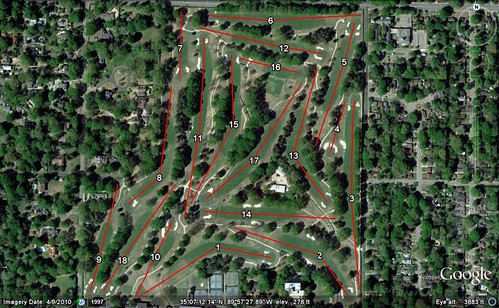A few years ago I received a set of photographs of the greens at Memphis CC assumed to be taken around 1940. Photographs were taken approximatlely 50 to 100 yards out on each hole. I thought I would share them with you three holes at a time for your enjoyment, enlightenment or comment. First, a little history on the course. According to
The History of Tennessee Golf: 1894 - 2001 Memphis CC's first golf couse opened in 1905 with nine holes designed by James Foulis. Tom Bendelow soon thereafter added another nine holes. According to multiple sources, including Brad Klein's
Discovering Donald Ross Ross re-designed/re-built the course in 1910, some ten years earlier than his next course in Tennessee. The course hosted the Western Open in 1913.
The course's unique routing remains unchanged. According to long-time superintendent Rod Lingle, many of the greens are original. However, as the 1940 photographs will reveal, they have generally shrunk and been rounded off. Unfortunately the photographs were discovered after the conversion of the greens to Champion Bermuda in 1999 and lost greenspace was not recaptured. Most notably, the twin 9th and 18th greens have been altered, as they were once merely separated by a single bunker. The 8th green has been revised and the slope of the 3rd green has been softened to accomodate the fast green speeds attained on the Champion Bermuda - reportedly as high as 14 on the Stimpermeter. The second and 10th greens have also been altered, the latter for the 1948 U. S. Amateur according to the aforementioned history book.
The course is situated on only 105 acres and in addition to those tournaments cited above, it hosted the 1920 and 1933 Western Amateur, the 1937 Women's Amateur, the 1959 Men's Senior Amateur and the 1979 Women's Amateur. The last two state amateurs held at Memphis CC were won by Danny Green and Tim Jackson, two of the nation's top amateurs and mid-amateurs.
Utilizing every inch of the property, Ross routed the front nine in a counter-clockwise direction along the property's boundary and then routed much of the second nine in two interior loops, including a brilliant example of triangulation in holes 15 through 17 as reflected in the following aerial:

The course tips out at 6,589 yards, playing to a par of 70.
Kris Spence has been retained by the club to re-work bunkers and tees and hopefully he will contribute to this thread. The first three photograhs will be posted tomorrow.